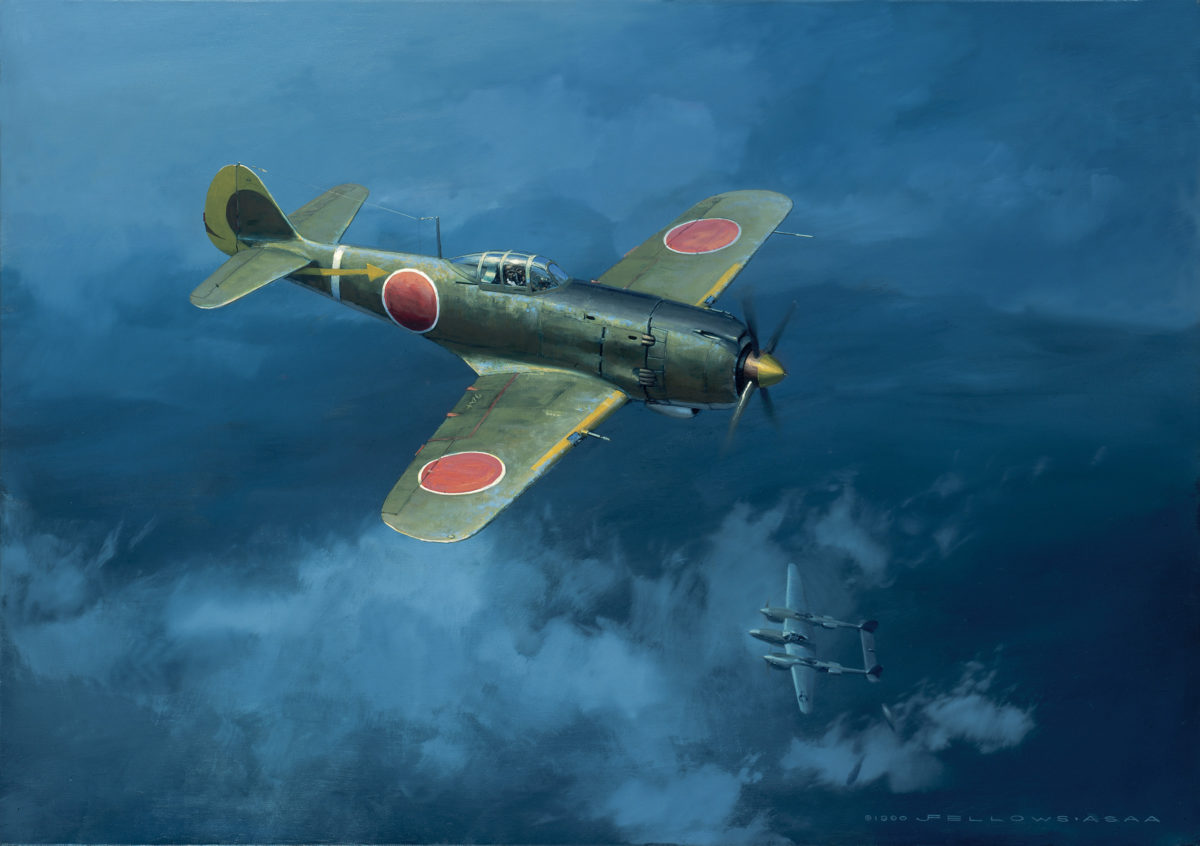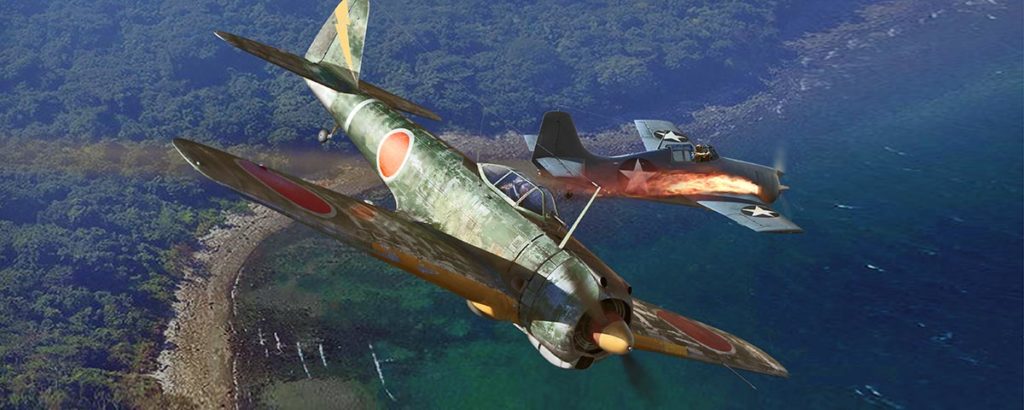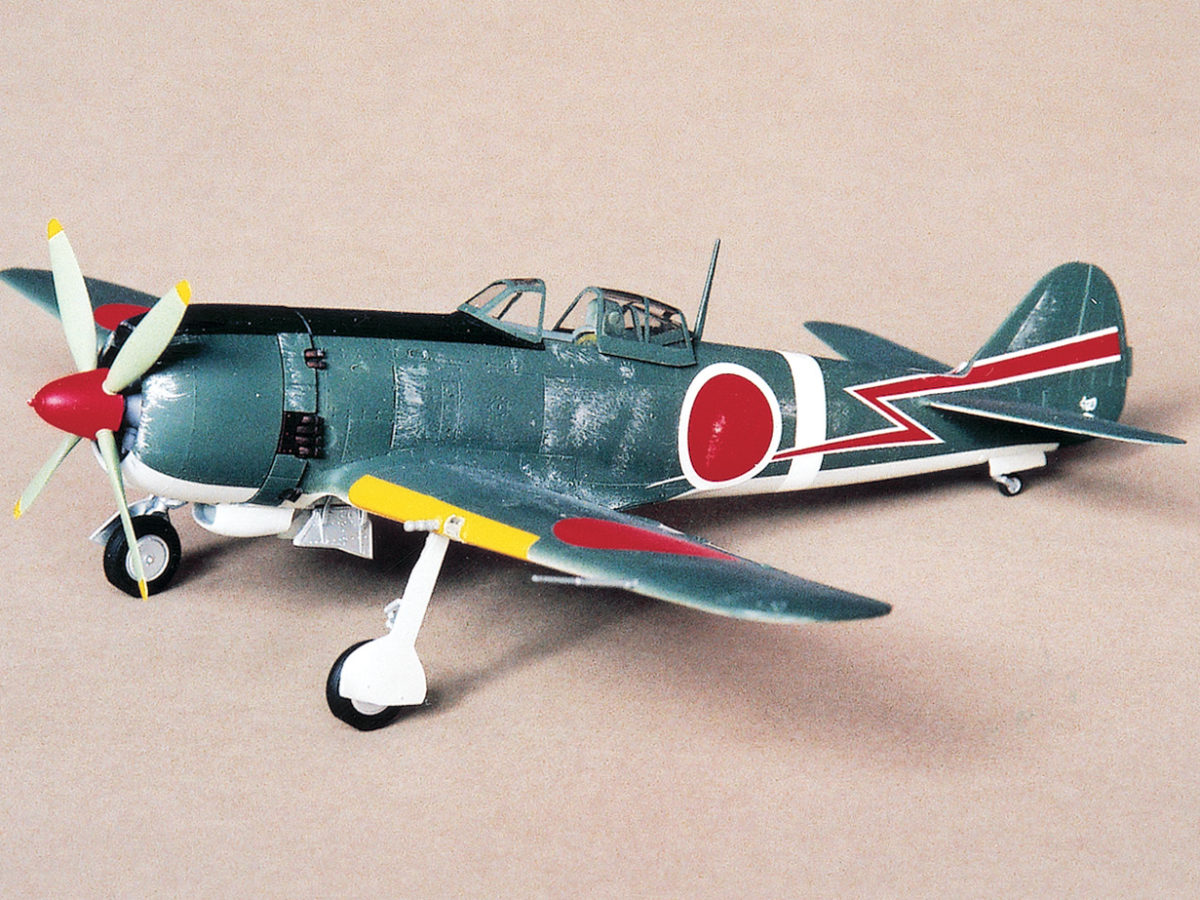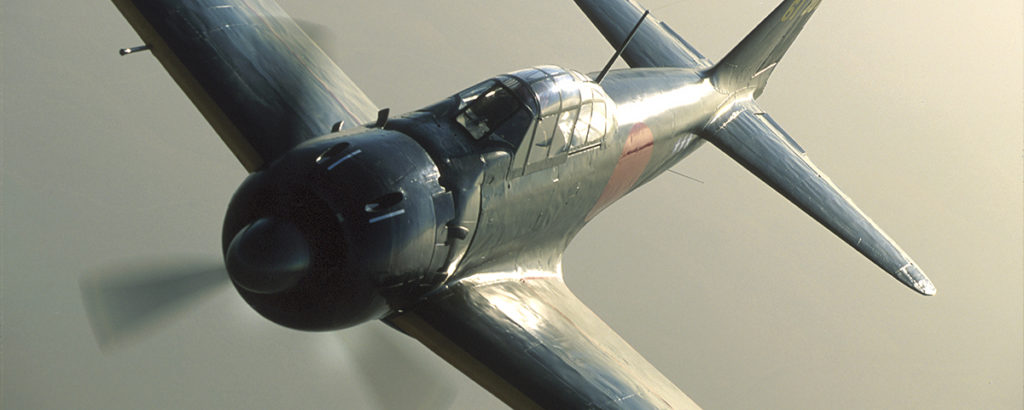On the morning of January 7, 1945, four Lockheed P-38L Lightnings of the Fifth Air Force’s 431st Squadron, 475th Fighter Group, were prowling the area between the Philippine islands of Mindoro and Negros. Their leader, Major Thomas B. McGuire Jr., had 38 Japanese planes to his credit, and he was impatient to surpass the 40 victories of Major Richard I. Bong, who shortly after becoming the American ace of aces had been sent home to take part in a war bond tour.
The four P-38s were sweeping the area at an altitude of 1,500 feet when Captain Edwin Weaver spotted a Nakajima Ki.43 Hayabusa (peregrine falcon) fighter of the Japanese Army Air Force (JAAF), known to the Allies by its code name “Oscar,” coming at them from below and to the left. McGuire and Weaver turned to attack it, but the Ki.43, flown by Master Sgt. Akira Sugimoto of the 54th Sentai (regiment), evaded them and fired a burst of 12.7mm bullets into the left engine of 1st Lt. Douglas S. Thropp Jr.’s P-38. Thropp sideslipped, then straightened out and prepared to release his drop tanks.
“Daddy Flight, save your tanks,” McGuire ordered over the radio—apparently confident that he could make short work of the Oscar. The fourth Lightning, flown by a visiting Thirteenth Air Force pilot, Major Jack Rittmayer, drove the Ki.43 off Thropp’s tail, but Sugimoto then attacked Weaver. Hastening to Weaver’s aid, McGuire pulled his Lightning into a tight turn. Just as he was about to get his sights on the elusive Oscar, his P-38, weighed down by those extra fuel tanks, abruptly fell into a full stall, snap-rolled onto its back and crashed in flames on Negros Island. For risking—and ultimately sacrificing—his life to save Weaver, America’s second-ranking ace was posthumously awarded the Medal of Honor.
Sugimoto did not long outlive McGuire. Although he escaped into the overcast, his Ki.43 had been so badly damaged by Thropp’s and Rittmayer’s fire that he had to make a wheels-up landing on Negros. Sugimoto was still trying to extricate himself from the cockpit when he was shot by Filipino guerrillas.
Even as the three remaining P-38s were losing the Oscar in the clouds, a second Japanese fighter suddenly emerged and attacked Thropp. Rittmayer went after the new enemy, which turned to meet him head-on. Given the Lightning’s armament of one 20mm cannon and four .50-caliber machine guns, such a face-off would have been suicide for an Oscar, but Rittmayer’s antagonist loosed a devastating volley that shattered the center nacelle and cockpit of his P-38. As the Japanese fighter turned on Thropp again, Weaver got some damaging shots into it, and it disengaged. Shaken by the loss of two good men, Thropp and Weaver headed for home.
Unknown to the Americans, their opponent was force-landing at his airstrip at Manalpa on Negros. The Japanese survivor of that deadly encounter was 21-year-old Tech. Sgt. Mizunori Fukuda, a former instructor who had recently been assigned to the newly formed 71st Sentai. He had been landing at Manalpa when he saw Sugimoto under attack and without further hesitation retracted his landing gear and rushed to his aid—too late to save Sugimoto, but in time to avenge him.
The aircraft in which Fukuda had scored his spectacular success had already established a reputation as the Allied fighter pilots’ worst nightmare. It had all the virtues of the nimble Oscar but none of its faults—inferior level and diving speeds, weak armament and vulnerability to damage that had made the difference between getting home, as Fukuda did, and crash-landing in the jungle, as Sugimoto had been forced to do. Fukuda’s mount was code-named “Frank” by the Allies, but to the Japanese it was the Nakajima Ki.84 Army Type 4 fighter, more popularly known as the Hayate (gale).
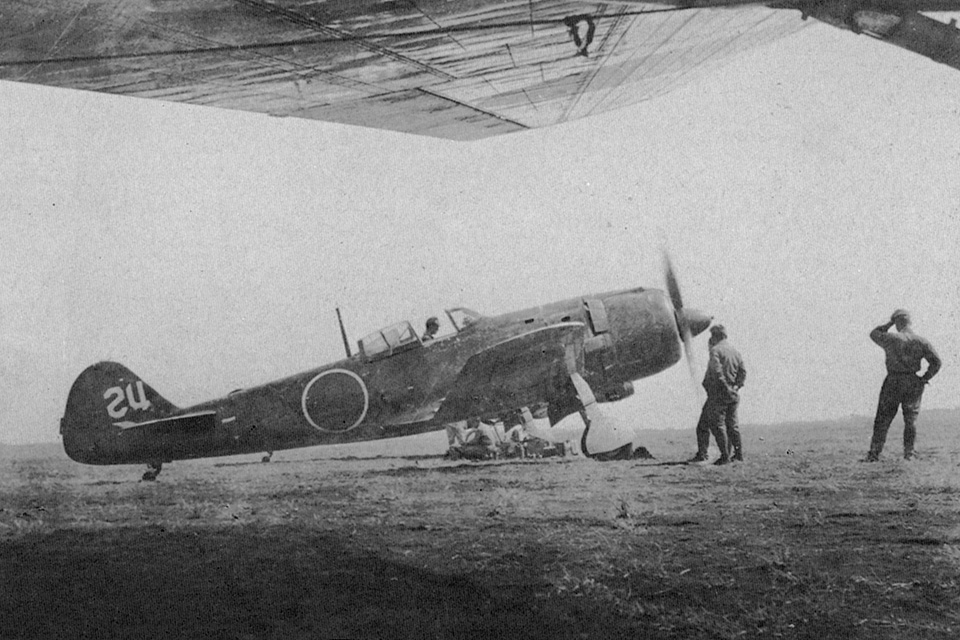
When Japan went to war with the United States and Britain on December 7, 1941, the Ki.43 was just entering service as the principal JAAF fighter. A few weeks earlier, however, army air headquarters was already asking for a successor. Like its famous naval stablemate, the Mitsubishi A6M2 Zero, the Hayabusa was fast and highly maneuverable, but its light construction made it just as vulnerable to enemy gunfire as the Zero, and it was not as well-armed as either the Zero or its Allied opposition. Anticipating an improved generation of Allied fighters, authorities wanted a plane that would combine the speed and climb of Nakajima’s new specialized interceptor, the Ki.44 Shoki (devil-queller, later dubbed “Tojo” by the Allies), with the Ki.43’s maneuverability, as well as heavy armament, armor protection and self-sealing fuel tanks. Powered by an army version of the navy’s new Nakajima NK9A Homare 18-cylinder, twinrow direct fuel-injection radial engine, the plane was to have a maximum speed of 400-420 mph. Early in 1942, Yasumi Koyama and the Nakajima design team began work on the new fighter, which was designated the Ki.84. Their design was approved on May 27, and such was the priority placed on the project that the first prototype emerged from Nakajima’s Ota plant in March 1943.
Like the Ki.43, the Ki.84 was a low-wing monoplane with the wing integral with the center fuselage to save the weight of heavy attachment points. The newer fighter, however, was much sturdier, with a heavy I-beam main wing spar. Both the wing and the semimonocoque fuselage were covered with stressed-skin light alloy, except for the metal-framed, fabric-covered ailerons. Hydraulically operated Fowler flaps were installed under the wing. The windshield incorporated 65mm of armor glass, while the pilot’s seat had 13mm of head and back armor. Armament comprised two synchronized 12.7mm Ho-103 machine guns in the fuselage and two wing-mounted 20mm Ho-5 cannons. Racks under the wings could carry either two 44-gallon drop tanks or up to 550 pounds of bombs. The Homare Ha-45 Model 11 engine was rated at 1,800 hp and drove a four-blade constant-speed Pe-32 propeller.
Secret flight testing began at Ojima Airfield in April 1943, and the enthusiasm with which test pilots reacted to the prototype led to the approval of 83 preproduction aircraft that summer. The principal handicap to the fighter’s development was the Ha-45 engine, which during trials suffered from drops in fuel pressure and the loss of power. The plane’s hydraulic system was also unreliable. While those problems were being remedied, Nakajima’s factories tooled up for full production of the Army Type 4 Fighter Model I-ko, the first of which left the Ota plant in April 1944. The army called for 2,565 Ki.84-I-kos by the end of the year, but continuing problems with the Ha-45 engines held up production until April 1944, when a rate of 100 engines a month was finally achieved.
Using an uprated Ha-45 Model 21 engine with an output of 1,860 hp, the Ki.84-I-ko had a maximum speed of 388 mph at 21,325 feet, a normal cruising speed of 236 mph and an initial climb rate of 3,790 feet per minute. Service ceiling was 36,090 feet, and the 780-mile range at normal cruising speed could be increased to 1,410 miles with the two drop tanks. The plane’s empty weight was 5,864 pounds, while the normal loaded weight was 8,192 pounds. Wingspan was 36 feet 2 inches, wing area was 226.02 square feet, length was 32 feet 61⁄2 inches and height was 11 feet 1 inch.
More of Japan’s wartime eagles
As the tempo of production rose during the summer of 1944, Hayabusa sentais began converting to the new fighter. The transition was relatively simple, but the Ki.84’s less docile ground handling characteristics caused some training accidents. In flight, its elevators tended to get heavy at high speeds, and its rudder got mushy at low speeds. Nevertheless, once they got used to it, JAAF pilots came to appreciate the Hayate’s better overall performance and heavier firepower.
The Hayate’s debut was calculated for maximum effect. On March 5, 1944, the 22nd Sentai was formed at Fussa, Yokota, with 40 Ki.84-I-kos and a pilot cadre drawn from the chutai (company) that had been evaluating the plane since October 1943. The new regiment’s commander, Major Jyozo Iwahashi, was a veteran of the undeclared 1939 war against the Soviet Union at Nomonhan, and had 20 victories to his credit. It was not until August 24, 1944, however, that the new fighter made its first appearance—in Hankow, China, at a time when Maj. Gen. Claire L. Chennault’s Fourteenth Air Force had nearly half of its combat strength committed in Burma, with the rest supporting Chinese and American efforts to halt a Japanese offensive toward the Yangtze River.
The 22nd had its first fight on August 29, when it engaged a large force of Curtiss P-40Ns of the Chinese-American Composite Wing (CACW), the 23rd Fighter Group and the 51st Fighter Group. As the Allied planes were returning from an attack on the railroad yards at Yochow, 1st Lt. Robert S. Peterson chased what he identified as a Zero off 1st Lt. James A. Bosserman’s tail, while 1st Lt. Forrest F. Parham, who claimed to have shot down a “Hamp” (A6M3 Model 32 Zero), probably downed a second and damaged a third. Lieutenant James Focht claimed to have damaged an Oscar, a Tojo and a Hamp. Clearly the Americans had no idea of what they were fighting, but they proved to be difficult opponents. On the Japanese side, Iwahashi was credited with a P-40N (possibly Bosserman’s, though he in fact returned safely to base) for the 22nd Sentai’s first victory.
Although the Allies had been hearing about a new Japanese army fighter since early in 1944, the Ki.84 came as a surprise, and its family resemblance to both the Ki.43 and Ki.44 probably resulted in its being misidentified in Fourteenth Air Force combat reports as either an Oscar or a Tojo. Over the next five weeks, the 22nd Sentai ran roughshod over the best opposition the Allies could offer. The regiment’s Ki.84s also joined in attacks on 90 China-based Boeing B-29s of the Twentieth Air Force’s XX Bomber Command, which dropped 206 tons of bombs on the Showa steel works in Anshan, Manchuria, on September 8. One B-29 was shot down during the raid, four others were damaged and two were forced to land in China, one of which was subsequently strafed on the ground by Japanese fighters. Superfortress gunners claimed eight enemy fighters.
Major Iwahashi was leading a strafing attack at Xian airfield on September 21 when he was hit by groundfire. Apparently deciding that he could not make it back, the 22nd Sentai’s commander dived his Hayate into the ground. According to some witnesses, he tried to crash into an enemy fighter parked on the field.
The 22nd’s rampage over China suddenly ended in October 1944, when it was transferred to Leyte to counter the imminent American invasion of the Philippines. In addition to that unit, the 51st, 52nd, 71st, 72nd, 73rd and 200th sentais were formed to use the Ki.84 in the Philippines, as were the veteran 1st and 11th sentais, which exchanged their old Hayabusas for Hayates that fall.
Meanwhile, on August 25, the 103rd Sentai had been formed for home defense, followed by the 101st and 102nd on Okinawa, and the 104th in Manchuria. The 85th Sentai in China began to supplement its Ki.44s with new Ki.84s in September, and the Shoki-equipped 29th and Hayabusa-equipped 50th sentais had also changed over to the Hayate by the end of the year. In sum, 1,670 Ki.84s had become operational in nine months, with 373 delivered in December 1944—the highest monthly production of any Japanese army plane.
One of the Ki.84’s most notable exponents was Captain Yukiyoshi Wakamatsu, commander of the 2nd Chutai, 85th Sentai, based at Canton. Although he had served in the JAAF since 1939, Wakamatsu did not come into his stride until July 24, 1943, when he shot down two Curtiss P-40s of the 74th Squadron, 23rd Fighter Group, over Kweilin while flying a Ki.44. He accounted for 11 more Allied aircraft while flying the Shoki. Just days after transitioning to the Hayate, he downed two North American P-51B Mustangs of the 23rd Group’s 76th Squadron over Wuchow on October 4, 1944, raising his tally to 15.
More than an ace, Wakamatsu was an inspiring leader whose disciples included Warrant Officer Akiyoshi Nomura. Soon after trading in his Shoki for a Hayate, Nomura downed two P-51s over Canton on October 15 before his own left wing and fuel tank were hit. Nomura bailed out, and on November 16, he claimed another Mustang over Zhaoqing.
Chennault launched his biggest counterstrike of the year against the Japanese on December 18, coordinating his efforts for the first—and only—time with the Twentieth Air Force. When 84 of XX Bomber Command’s B-29s dropped 511 tons of bombs on Hankow, the Fourteenth Air Force’s Consolidated B-24s and North American B-25s added to the destruction, while fighters of the 23rd Group and the CACW flew interdiction strikes against known JAAF airbases.
The Japanese had anticipated the attack, and Wakamatsu’s 2nd Chutai had moved to the satellite airfield outside Wuchang, to reinforce the 85th Sentai’s 1st Chutai at Hankow. Reports of oncoming B-29s sent Wakamatsu rushing skyward to intercept, but he was still retracting his landing gear when he was attacked by 10 of his old enemies, Mustangs of the 23rd Fighter Group, and shot down. He was probably the victim of the group’s deputy commander, Lt. Col. Charles H. Older, or Captain Philip G. Chapman of the 74th Fighter Squadron, both of whom claimed an Oscar over the Wuchang satellite field. At the time of his death, Wakamatsu had 18 victories, half of them allegedly P-51s.
The rest of the 85th Sentai’s fighters engaged the B-29s and their escorts over Hankow but were overwhelmed by the combined American fire power, Nomura was the only pilot of his regiment to return from the air battle alive and unwounded. Later operating from Seoul, Korea, Nomura participated in the 85th Sentai’s last combat on August 13, 1945, and survived the war with 10 victories.
Back at Ota, Nakajima’s design team continued to develop the Ki.84 in two different directions—to improve its performance and reliability, and to adapt it to the growing problems of Japan’s besieged industrial capabilities. The Ha-45 Model 11 engine was replaced by the 1,825-hp Model 12, then by the fuel-injected 1,970-hp Model 23—the latter of which finally eliminated the fuel pressure problem. Armament was also increased—four 20mm Ho-5 cannons in the Ki.84-I-otsu, and two wing-mounted 30mm Ho-105s in an antibomber variant called the Ki.84-I-hei. To conserve light alloy, Nakajima designed the Ki.84-II Hayate–Kai, which had a wooden rear fuselage and wingtips, and which entered service in the late spring of 1945. Even more wood was to be used in the Ki.106, which was ordered on September 8, 1943, but the first three prototypes were not completed and flown until July 1945. Another attempt to economize on the Ki.84 design was the Ki.113, which used carbon steel for the main airframe components, while the Ki.116 was developed to use the 1,500-hp Mitsubishi Ha-112-II 14-cylinder radial as an alternative power plant, in case American bombing attacks made the Ha-45 unavailable. As late as June 1945, headquarters was considering proposals for high-altitude interceptors based on the Ki.84 design, using supercharged engines, but the war ended before serious work could begin on any of those projects.
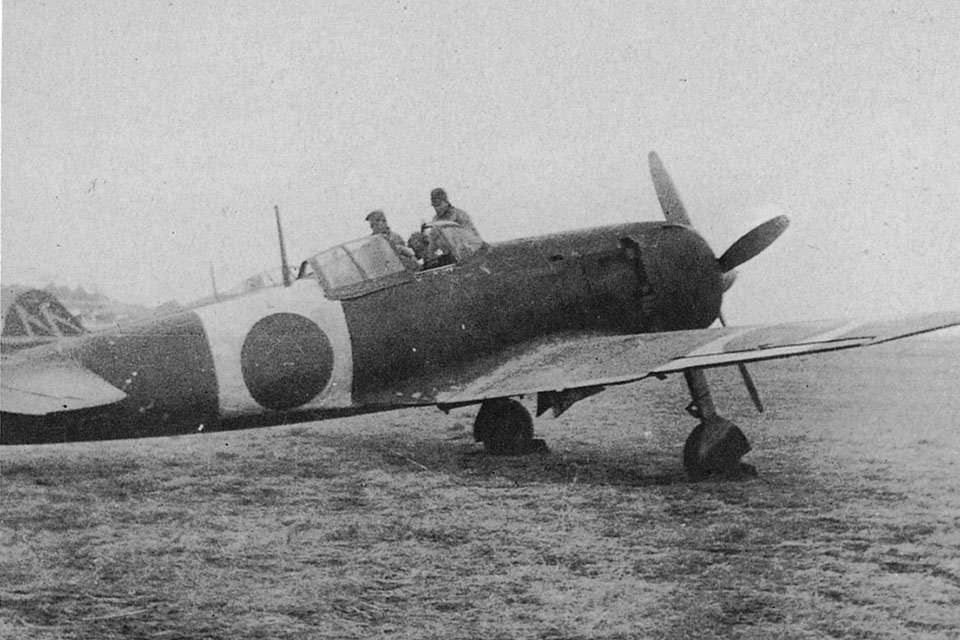
In the Philippines, the Hayate proved a worthy adversary for American fighters when flown by a competent pilot. One veteran who was tasked with ferrying Ki.84s to those islands was more than competent—Sergeant Satoshi Anabuki, who had previously flown Ki.43s over Burma with the 50th Sentai. Anabuki downed or damaged six Grumman F6F-5 Hellcats in the course of several ferry flights to the Philippines, and later added a B-29 to his claimed total of 51 victories. Equally remarkable, he survived the war.
Another of the more fortunate Ki.84 pilots was Master Sgt. Katsuaki Kira, a veteran of Nomonhan and New Guinea who was transferred to the newly formed 200th Sentai at Negros in October 1944. The 200th soon came into contact with P-38s of the crack 49th Fighter Group, and on October 29, it lost a chutai commander and eight-victory ace, Captain Masao Miyamaru, probably to 2nd Lt. Milden Mathre of the 49th’s 7th Squadron. While defending a troopship convoy from an American air attack on November 1, Kira took on 10 Lightnings single-handed and was credited with two—though the 7th Fighter Squadron only lost one, and Filipino Volunteer Guards helped its pilot, Captain Elliott Dent, make his way back to his unit on the 15th. Kira was promoted to warrant officer for his feat, but his comrades were less fortunate—1st Lt. Masatane Nakatake was killed that day, in which the 49th Fighter Group claimed 25 Japanese planes. After its first month of combat, the 200th Sentai was down to nine aircraft. By the time it was withdrawn in January 1945, the unit had been all but annihilated. Reassigned to the 103rd Sentai, Kira survived the war with 21 victories.
November 1 also saw the Fifth Air Force strike at Fabrica airfield, destroying 10 Ki.43s on the ground, and at Bacolod, destroying 26 planes and damaging 16 others. During the raids, Major Tsuneo Nakajima, commander of the 51st Sentai, claimed two B-24s. Two days later, Sgt. Maj. Fujio Tsunemi of that same unit claimed two P-38s, for which he was cited and promoted to warrant officer.
The Americans were becoming more familiar with the Frank by November 18, 1944, when two P-38s of the 49th Fighter Group’s 8th Squadron, flown by 1st Lt. Edward Glascock and 2nd Lt. Gerald Triplehorn, left Leyte’s Bayug airfield on a morning patrol. After 15 minutes, Glascock shot down a Zero west of Bayug, but half an hour later the duo encountered a quartet of Franks north of Tacloban. Glascock immediately attacked one, but soon found himself fighting for his life against this faster, well-handled adversary. He eventually drove his opponent down, but young Triplehorn was outfought, and after trying to nurse his riddled Lightning back to Tacloban, crashed into the mountains and died. Glascock managed to disengage from the remaining Hayates and returned alone.
In addition to its primary fighter role, the Ki.84 was used as a dive-bomber, carrying 66-pound or 110-pound bombs under the wing racks. In spite of its inherent merits, however, the Hayate was still outnumbered, and the lax production standards that attended its rush into service resulted in chronic hydraulic malfunctions, brake failures, broken landing gear legs and a general maintenance headache for the ground crews. Although the Hayates gave a good account of themselves, steady attrition—as much due to operational malfunctions as to combat—effectively drove them from the Philippine skies. By March 1945, the 73rd Sentai had been virtually annihilated. In that same month, however, three more sentais were equipped with Ki.84s—the 20th on Formosa, the 13th in Indochina and the 25th in China.
By then, U.S. Navy carrier planes had joined the B-29s in striking at the Japanese Home Islands. During one such raid on Kure naval base on March 19, Sgt. Maj. Yukio Shimokawa, a 16-victory ace who was serving as a ferry pilot at Ozuki airfield while recovering from wounds—including the loss of an eye—jumped into a Ki.84 and led nine Ki.43s to intercept the Americans. The Japanese were in turn jumped by F6F-5s of VF-17 from the carrier Hornet, which wiped out the entire flight. Shimokawa damaged two Hellcats before being shot down by Lt. j.g. Tillman E. Pool. Shimokawa bailed out just as his plane exploded, and though badly burned, he survived.
On April 1, the Americans invaded Okinawa. The 47th, 52nd, 101st and 102nd sentais rose to the island’s defense, but they were soon overwhelmed in a series of preliminary sweeps by Hellcats and Vought F4U-1A Corsairs.
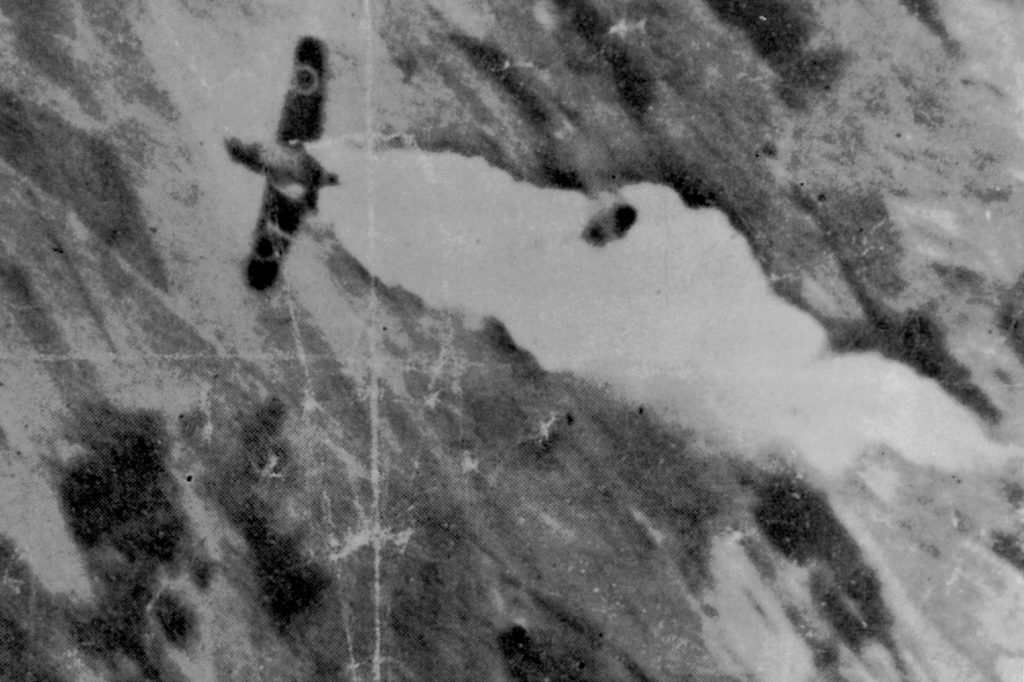
In the early morning hours of April 16, 11 Hayates of the 103rd Sentai’s 3rd Chutai set out to bomb airfields that the Americans had established on the island at Yontan and Kadena. Radar detected the incoming marauders, and two were intercepted and shot down by F6F-5N Hellcats of Yontan-based Marine night fighter squadron VMF(N)-542, flown by 2nd Lts. Arthur Arceneaux and William E. Campbell. The rest pressed on and caused some damage to the airfields, but on the way back, they encountered F6F-5s from VF-17. Lieutenant junior grade Murray Winfield, who had downed an Oscar in the March 19 fight, added a Frank to his score, while Lt. j.g. Charles E. Watts shot down two. Only three Ki.84s returned, including 1st Lt. Shigesayu Miyamoto, who was wounded but managed to force-land in an inlet on Tokuno Island.
The growing disparity in training between American and Japanese pilots was shown on April 17, when Lieutenant Eugene A. Valencia of carrier Yorktown’s VF-9 shot down six Franks, probably downed a seventh and damaged another, while his wingman, Lt. j.g. Clinton Lamar Smith, accounted for one Frank and one probable. JAAF pilot losses totaled eight that day, including Captain Masao Suenaga, commander of the 101st Sentai, and 1st Lt. Kanji Nagakura of the 102nd. Valencia’s well-drilled four-man “Flying Circus” struck again on May 4, with Smith bagging one Frank, Lieutenant James B. French getting another and Lt. j.g. Harris E. Mitchell downing two, along with the Mitsubishi Ki.46 reconnaissance plane they were escorting.
On May 25, Captain Tomojiro Ogawa led 10 Ki.84s of the 103rd Sentai in another attempt to strafe Yontan airfield, only to be intercepted by Marine Corsairs. Ogawa, the only pilot in the formation with any combat experience, was the only one to return.
Assigned to several Shimbutai (morale-raising) units whose actual purpose, like that of the naval kamikazes, was to crash into Allied ships, Ki.84s were primarily meant to escort suicide planes against the U.S. Fifth Fleet off Okinawa, strafing American warships on the homeward leg of their sorties. Often, however, Hayate pilots tried to play kamikaze. The 102nd Sentai failed to score a single air-to-air victory between December 1944 and March 1945, which might explain why six of its frustrated pilots opted to dive their Ki.84s at enemy ships during the Okinawa campaign. Some units defending Japan against B-29 bombing raids tried to ram the Superfortresses in midair.
Their desperation was well-founded. On February 10, 84 B-29s bombed Nakajima’s Ota plant, destroying or damaging 74 Hayates on the assembly line. B-29 strikes on the firm’s Musashi plant on April 20 brought Ha-45 engine production to a standstill, although it subsequently resumed at the Hamamatsu plant and in an underground factory at Asakawa. Training was also deteriorating, with new Hayate pilots going into battle with only about 200 flying hours.
The Ki.84’s ruggedness was reflected in the high percentage of pilots who rammed B-29s and survived. Often they were awarded the Bukosho, a Japanese equivalent of the Medal of Honor instituted by Emperor Hirohito on December 7, 1944. The award broke from the Japanese tradition of honoring heroes only after death. One recipient was Warrant Officer Kenji Fujimoto of the 246th Sentai, who was credited with three B-29s, including one from the 499th Bomb Group that he rammed and brought down on March 13, 1945. After he rammed a second B-29 over Kobe on March 16, Fujimoto was awarded the Bukosho.
Another, somewhat less drastic method of fighting B-29s was employed by Master Sgt. Isamu Sasaki, a veteran of the Burma front who had returned to Japan to work at the Army Flight Test Center at Fussa. When 27 B-29s of the 6th Bomb Group struck Tokyo on the night of May 25, Sasaki took off in an unmarked Ki.84-I-ko. Flying above the American formations, he would select a target silhouetted against the burning capital, then dive at it head-on. In that manner, he was credited with shooting down three B-29s that night (the 6th Group actually lost three planes, plus 14 damaged). Sasaki was awarded the Bukosho and promoted to warrant officer for destroying six B-29s and damaging three, and survived the war with a total of 38 victories.
The fall of Iwo Jima to the Americans in late March 1945 added a new nemesis for the Ki.84 pilots as they tried to stop the waves of B-29s bombing their homeland— P-38Ls, P-51Ds and Republic P-47N Thunderbolts of the Seventh Air Force. On June 10, 300 Tokyo-bound B-29s were met by 120 Japanese fighters, but Mustangs of the 15th and 506th Fighter groups, flying escort at 23,000 feet, were ready to intervene. Finding several Ki.84s entering the bomber stream, Major Robert W. Moore, commander of the 15th Group’s 45th Fighter Squadron, attacked one, but it escaped in a split-S maneuver. Latching onto another’s tail, “Todd” Moore was led on a merry chase involving turns, chandelles and a 700-foot power dive before he finally saw pieces fly off his quarry and the Frank plunged earthward, probably killing the 52nd Sentai’s commander, Captain Shiro Ban-nai.
Even as late as August 8, however, Hayate pilots could prove to be full of fight. When 44 P-47Ns of the 318th Fighter Group escorted the 58th Bomb Wing’s B-29s over Yawata, Kyushu, they got into a running battle with some aggressive Ki.84s. Four Franks were claimed by 1st Lt. Edward M. Freeman, 1st Lt. Robert W. Redfield, 2nd Lt. William J. Cuneo and 2nd Lt. Frederick S. Johnson, but the group lost four Thunderbolts and three pilots: 2nd Lts. Lloyd Henley Jr., Harley C. Kempter and Churchill A. Marvin. One of the last actions of the 318th Group occurred on August 14, when Captain Douglas V. Currey of the 333rd Squadron damaged a Kawasaki Ki.61, then spotted a lone Frank 10 miles east of Osaka and poured tracers into its fuselage. Currey reported seeing the Japanese pilot bail out before he rejoined his flight on the long trip back to Ie Shima, but his victim, Warrant Officer Kenji Fujimoto, was in fact killed.
On the following day, Emperor Hirohito announced Japan’s unconditional surrender and ordered all units to stand down. By then, the Ki.84 was numerically the JAAF’s most important fighter, with a total 3,470 built. Representing a brilliantly executed change in Japanese fighter doctrine, the Hayate was never outclassed by its opponents, but the situation under which it entered service hobbled its ability to reverse Japan’s already doomed war effort.
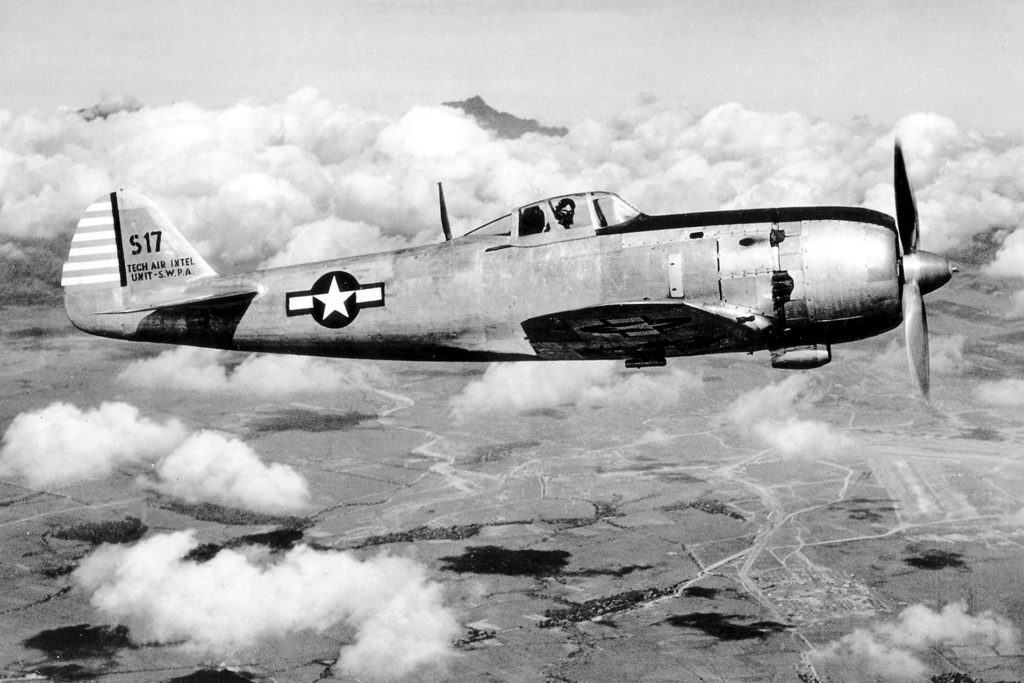
The Hayate was impressive enough with a good pilot and adequate maintenance, but only after the war did the Americans learn how much deadlier an opponent they might have faced. In 1946 a Ki.84-I-ko of the 11th Sentai’s 2nd Chutai that had been captured intact at Clark Field, Luzon, underwent 111⁄2 hours of flight testing at Wright Field, near Dayton, Ohio. Although its shoddy construction and recurrent hydraulic problems gave the Americans as much trouble as they had given its original owners, the evaluators’ ultimate conclusion was that the “Hayate was essentially a good fighter which compared favorably with the P-51H Mustang and the P-47N Thunderbolt. It could outclimb and outmaneuver both fighters, turning inside them with ease, but both P-51H and P-47N enjoyed higher diving speeds and marginally higher top speeds.”
That the earliest model of the Ki.84 had compared so well with the latest models of Mustang and Thunderbolt said volumes about the soundness of its design. Of equal significance was the fact that this Hayate was using 100 octane fuel for probably the first time in its career—the Franks that the Americans had met in combat used lower-grade 80 octane fuel, often tainted with dirt, water and the odd tropical insect.
After its evaluation program ended in June 1946, the Ki.84 was passed on to the National Air Museum of the Smithsonian Institute until funding limitations led to its being passed on to the Ontario Air Museum at Claremont, Calif., which allowed it to be flown in a film or two. Finally, in 1973, it was acquired by Morinao Gokan, president of the Japanese Owner Pilots’ Association, who brought the last Hayate home. It is currently preserved at the Chiran Kamikaze Memorial Museum in Kagoshima.
For further reading, senior editor Jon Guttman suggests: Japanese Army Air Force Fighter Units and Their Aces, 1931-1945, by Ikuhito Hata,Yasuho Izawa and Christopher Shores; and Japanese Army Air Force Aces, 1937-45, by Henry Sakaida.
Originally published in the May 2006 issue of Aviation History. To subscribe, click here.

